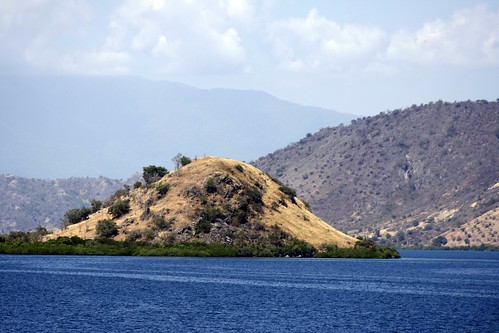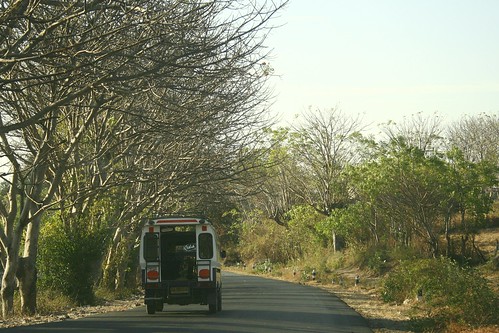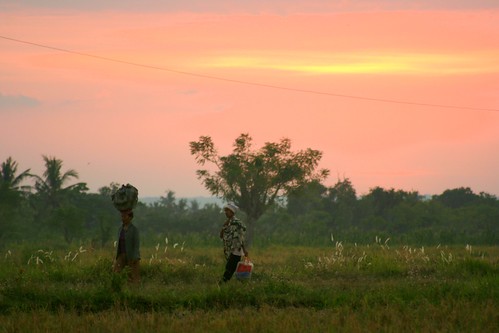Sumbawa: sprinting through volcanoes and dowry parades
I examined the map and squinted. "We can do Lombok to Sumbawa Besar by car in one day, you say?" My tone was incredulous but my friends avered that, yes, it can be done. Their math seemed to check out: 2 hours from Mataram to Labuhan Lombok, plus 2 hours ferry crossing, then 2 hours to Sumbawa Besar. Doubled the 6 hours for the trip way back and added some allowance and begrudgingly, I admitted that on paper it can be done.
The day did not start as early as we would have wished. There was some miscommunication and our transportation pickup from Teluk Kodek in Northwest Lombok was late. Another delay by our car rental at Mataram meant we only were able to leave the capital at 9AM.
Fortunately, roads in Lombok already are fully paved. East Lombok hiways are still mostly narrow but there were no potholes which were aplenty way back in the early 90s. However, it already was 11:30 when we turned by the circular bay of Labuhan Lombok, not 11AM as we would have desired. To our consternation, we missed the ferry by 5 minutes at the port of Kayangan. Ferry turnover was unexpected slow and it was not until 12 noon that we were able to load the car inside the ferry.
In the map, Selat Alas, or the Alas Strait in English, looks quite narrow but the ferry is not exactly the fastest moving boat either. We entered the bay of West Sumbawa in a little more than an hour but we had to wait for an empty berth at the port of Poto Tano so it wasn’t until 1:30 that we finally were on dry land again.
Canon EOS 350D Digital, 1/100s, f/5.0, 150mm, ISO 100
one of several small islands across Poto Tano, West Sumbawa, Sumbawa Island, Nusa Tenggara Barat, Indonesia
Nothing touristy is in Sumbawa save for perhaps the pristine world-class surf breaks in the regencies of Bima and Dompu which only the most avid surfers seek and the volcano park of Tambora.
Tambora, if you don’t know, is the volcano which produced the most violent explosion in modern history when in 1815, expelling enough ash into the atmosphere that produce a "year without a summer" in North America and Europe, resulting to the worst famine of the 19th century and killing >70,000 people.
Canon EOS 350D Digital, 1/3200s, f/4.0, 75mm, ISO 100
a chain of small islands around Poto Tano, West Sumbawa, Sumbawa Island, Nusa Tenggara Barat, Indonesia
The fantastic eruption consequently wiped away the entire vegetation of Sumbawa which still is bald and scorched to this day. The entire island is as dry as you can get. The rugged sandy terrain of East Lombok is nothing compared to the arid desert-like earth of Sumbawa peninsula. This entire 15,500 sq km island, one of Indonesia’s largest stretching from West Sumbawa through Sumbawa Besar and Dompu in the central region up to Bima in the east, is notorious for being a brown dust bowl during hot season – and August is summer.
Canon EOS 350D Digital, 1/1600s, f/5.0, 160mm, ISO 100
typical topography of Sumbawa during summertime, Poto Tano, West Sumbawa, Sumbawa Island, Nusa Tenggara Barat, Indonesia
Along the coast, there were hardly any major thickets of green forest. The highways are curiously lined by kapok and other trees that are strange-looking to me, leafless and almost lifeless. I remember that this is eastern part of Indonesia where flora and fauna are no longer Asian but Australian in character. (Read more on the famous Wallace_line.)
Canon EOS 350D Digital, 1/1000s, f/5.6, 55mm, ISO 400
leafless trees are a feature in Sumbawa Besar, Sumbawa Island, Nusa Tenggara Barat, Indonesia
Time went fast. We tried to cover the some 80km distance from Poto Tano to Sumbawa Besar but the best we could do was 2.5 hours, including a pit stop at Utan, West Sumbawa, for a quick lunch and a tire change.
By 4PM, we already were in quandary. We just arrived in Sumbawa Besar and by my estimation, we still are some 100km away from Kwangko, the nearest seaweed farm eastward. We pushed our luck. Some 30 minutes of driving could only get us as far as Moyo. It was 4:30PM. Even if we could get to Kwangko in an 1.5 hours, it would already be too dark to see any seaweed and too dangerous to get into any boat.
Having traveled 7.5 hours, we called off the trip and turned back. One thing became obvious, a Lombok-Dompu-Lombok road trip cannot be done in 15 hours. At least 18 hours is needed. The best itinerary to visit the seaweed farms in Sumbawa Besar and Dompu was the one we originally made: fly to Bima and work our way westward through Dompu and then Sumbawa Besar. However, Bima, being not a popular destination in Nusa Tenggara Barat (West Central Islands) gives to fickle flight schedules and the bookings we had the previous week were canceled arbitrarily.
Failure can easily turn to frustration but we merely shrugged it off. No, we laughed it off. Sure we grossly underestimated the distance but the road trip was fun. Sumbawa, the mercilessly hot land, is not like any Indonesian island I have visited and curiosity was sated. Too bad that in our vain drive to get to our destination we could not make more stops.
The sights in Sumbawa were unique. In Sumbawa Besar alone, I witnessed not one but two dowry parades, an age-old Muslim practice that is disappearing elsewhere in secular Indonesia. Apparently in Sumbawa, dowry parades are still the norm. They are given by the groom to the bride’s family in recognition for the loss of a daughter, as payment for the wedding cost, or as giveaway property to the new couple. The motorcades I saw featured curious bulky material properties being brandished atop pickup and trucks. I saw mattresses, cavans of food, traditional offerings of bamboo and sugar cane and large pieces of furniture like the cabinet below. Obviously, proud are the groom’s families who could afford to display these luxurious gifts.
Canon EOS 350D Digital, 1/800s, f/1.8, 50mm, ISO 100, +4/3 EV
a dowry caravan in Sumbawa Besar, Sumbawa Island, Nusa Tenggara Barat, Indonesia
Our trip back to Lombok was no less animated. Company became more enjoyable. Perhaps fun can be the domain of the frustrated. We were on the road at Utan when the sky turned red on us. Unfortunately, while we were traveling west, Sumbawa’s rugged terrain was blocking the sun. Nevertheless, a missing sun would not preclude me from enjoying the golden hour. The sky was a remarkable hue of pink – Sumbawa is definitely not industrial – so pollution was entirely absent. I took a few shots of rustic Utan, nothing fancy really, just some cows lazing by and women going home.
Canon EOS 350D Digital, 1/125s, f/5.6, 300mm, ISO 400
a rural scene during sundown at Utan, Sumbawa Besar, Sumbawa Island, Nusa Tenggara Barat, Indonesia
When we got turned around a bay in the district of Alas, we came upon the majestic silhouette of Rinjani, Indonesia’s highest mountain outside of Irian Jaya. When all things go sour, somehow, nature’s sublime beauty could still manage to warm the weary soul, or in my case, entertain me and my lens.
Canon EOS 350D Digital, 8.00s, f/16, 55mm, ISO 100, +1EV
the silhouette of Mt. Rinjani, soaring over Alas, Sumbawa Besar, Sumbawa Island, Nusa Tenggara Barat, Indonesia
The way back to Mataram was a blur. Again, we missed the boat back to Lombok by minutes. Story of our lives! Having had 30 minutes to burn, we had dinner at a local eatery by the Poto Tano harbor. By 8PM, we got into the ferry and nabbed some much needed nap. We got off at Labuhan Kayangan at 9:30PM. Two hours later, we arrived in our hotel in Senggigi, northwest of Mataram.
Canon EOS 350D Digital, 1/100s, f/1.8, 50mm, ISO 1600, +1/3EV
my dinner of fried shrimps in Poto Tano, West Sumbawa, Sumbawa Island, Indonesia
After 15 hours on the road, alertness turned to exhaustion. I just realized that we were able to skim through five of the seven regencies of Nusa Tenggara Barat province in one day: Lombok Barat, Lombok Tengah, Lombok Timur, Sumbawa Barat and Sumbawa Besar. It is not something that I would have the time to do again but certainly, sometime soon, I hope to visit Bima and Dompu. And beyond too.






4 comments:
Seminar arranged by Rainbow against Dowry
"Dowry is a social malady that degenerates the self-dependent mentality of the men. Apart from that, the custom hinders a good relationship between the provider and receiver of dowry, and as a result, creates problems between families and within the society. Each year this custom costs a large number of women their life while it causes many other women to live a degraded life"- this was the speech from chief guest Mr. R Jamir, Director of MATADOR, at the seminar arranged by Rainbow Nari O Shishu Kalyan Foundation against the dowry custom. Mr. Md. Sohel Alam, the representative from the Qatar Charity Found, Rashal Md. Iqbal Khan the Representative from the PKSF were also present at the seminar as the special guest. Director of Rainbow Md. Altaf Hossain Mahabul read the main article at the seminar. Amongst others who presented their speeches on the occasion were social workers like Mr. Mahbub Alam, Md. Mizanur Rahaman Scientific Officer of PPRC, Mohammad Khairul Alam Executive Director of Rainbow Nari O Shishu Kallyan Foundation and Kazi Nafiza Shultana Chairman of Rainbow. People from different levels of the community participated in the seminar from the areas of Lalbagh, Hajaribagh and Kamrangirchar.
09th August 2008
I'll be touring Sumbawa by (own, 4WD) vehicle in early October...Lombok's Rinjani is Indonesia's second tallest volcano. Kerinci in Sumatra is taller.
Hi,
Very nice pictures and blog. I will be going to Lombok early next month, after reading you blog & pictures feels very excited and looking forward for the trip.
Gr8 pictures :)
Regards,
Saumya
Lombok and Sumbawa are truly different. To those who would be lucky to go there, enjoy!
Post a Comment